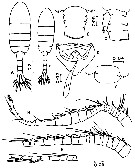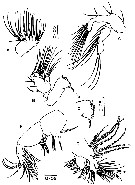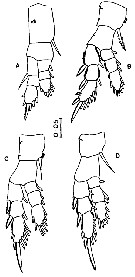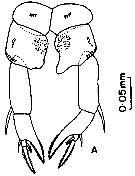|
|
 |
Fiche d'espèce de Copépode |
|
|
Calanoida ( Ordre ) |
|
|
|
Diaptomoidea ( Superfamille ) |
|
|
|
Pseudodiaptomidae ( Famille ) |
|
|
|
Pseudodiaptomus ( Genre ) |
|
|
| |
Pseudodiaptomus pankajus Madhupratap & Haridas, 1992 (F,M) | |
| | | | | | | Ref.: | | | Madhupratap & Haridas, 1992 (p.555, figs.F,M) |  Issued from : M. Madhupratap & P. Harida in J. Plankton Res., 1992, 14 (4). [p.556, Fig.1].
Female (from Gulf of Kutch): A, habitus (dorsal); B, urosomite 1 (dorsal); C, urosomite 1 (left lateral view); D, ventral genital field with spermatophore; E, A1.
Male: F, habitus (dorsal); G, urosomite 1 (dorsal); H, right A1.
Scale bars in mm.
Female:
- Head and 1st pediger separate, 4th and 5th fused.
- Posterior corners of metasome rounded with 1 pair of posteriorly directed dorsal spines and spinules between spines and urosome insertion.
- Urosomite 1 symmetrical with 3 rows of lateral spinules extending incompletely dorsal terminating in a seta. Genital field with a row of proximal spinules.
- Urosomites 1-3 with posterodorsal spine rows (spines on Ur3 largest).
- Caudal rami 3 times longer than wide with 5 setae and a dorsal setule; middle seta slightly swollen.
- Urosomites segments and caudal rami with proportions 29 : 17 : 16 : 15 : 23 = 100.
- A1 22 segmented with modified barbed seta on segment 20.
Male:
- Prosome - urosome ratio: 1.6 : 1.
- Posterior corners of metasome with 1 pair of small dorsal spines.
- Urosomite 1 with incomplmete dorsal spinule row at midlength.
- Urosomites 2-4 with postrodorsal spinule rows.
- Caudal rami 3 times longer than wide with setulation similar to female except that middle seta is not swollen.
- Urosme segments and caudal rami with proportions 12 : 19 : 17 : 17 : 15 : 20 = 100.
- Right geniculate A1 21-segmented; geniculation between segments 17 and 19 with flanges; segment 18 with comb plate of spinules.
- Other mouth parts and P1-P4 similar to female.
|
 Issued from : M. Madhupratap & P. Harida in J. Plankton Res., 1992, 14 (4). [p.557, Fig.2].
Female: A, A2; B, Md; C, tip of the gnathal lobe of Md; D, Mx1; E, Mx2; F, Mxp.
Scale bars in mm.
Nota:
- Gnathal lobe of Md with about 16 teeth and seta.
- 4 modified bristles present on inner lobes of Mxp.
|
 Issued from : M. Madhupratap & P. Harida in J. Plankton Res., 1992, 14 (4). [p.558, Fig.3].
Female : A, P1; B, P2; C, P3; D, P4.
Scale bar in mm.
|
 Issued from : M. Madhupratap & P. Harida in J. Plankton Res., 1992, 14 (4). [p.559, Fig.4 A].
Female; A, P5 (anterior view).
Nota: P5 asymmetrical. coxa (B1) with proximal spinule row, basis (B2) with large posterior surface seta, very fine proximomedial spinule patch and a distal spinule row continuing on to lateral surface. Left basis (B2) extending over proximal corner of exopodal segment 1 with large bulbous ptojection at distomedial corner; right basis (B2) also extending over exopodal segment 1 with irregular medial margin. Exopodal segment 1 wit naked seta, exopodal segment 2 with stout medial spiriform process, both margins hirsute and small naked seta. Exopodal segment 3 with proximomedial spiniform process slightly lo,nger than exopodal segment 2 spiniform ptocess and appears divided distal to origin of basal process.
|
 Issued from : M. Madhupratap & P. Harida in J. Plankton Res., 1992, 14 (4). [p.559, Fig.4].
Male: B, P5 (posterior view); C, P5 (anterior view).
Scale bar in mm.
Nota: P5 posterior view : Coxa (B1) distomedial corners acute. Right leg -, basis (B2) with 1 large surface seta at midlength, 2 distal setae, rows of proximomedial spinules and a row of dorsolateral spinules. Endopodite consists of 2 processes, both oroiginating from the same base at the disyomedial corner of basis and with a hyaline process having an apical cleft in the middle. Medial process of endopodal spinifotrm with seta at the tip, lateral process stout, apex bulbous with irregular margin and a corona of small spinules. Exopodal segment 1 roughly triangular with a circular cluster of spinules at midlength, sculptured with 3 distolateral small ridges, 2 surface setae and distolateral corner ending in a small spine like process; outer seta long, recurved, reaching 3/4 of exopodal segment 2 with proximopmedial margin heavily serrate. Exopodal segment 2 elongate with distomedial knob, surface seta at midlength and outer seta 3/4 the length of segment. Exopodal segment 3 proximomedially swollen with spinules and 2 setae and tip finely serrate.
Left leg basis (B2) with large surface seta, seta on medial margin and a distolateral row of spinules. Large recurved endopod originating from distomedial corner of basis, extending past midlength of exopodal segment 2, base swollen, apex with distomedial spinules and ending in a circular row of long spines. Exopodal segment 1 simple with naked outer seta. Exopodal segment 2 large, flattened and hemispherical with long outer seta, 3 surface setae and 1 terminal seta, medial margin with 3 setae.
Anterior view: coxa (B1) with spinule row. Basis (B2) with row of spinules at midlength continuing on to the lateral sides and distal spinule row. Right exopodal segment 2 with fine distal spinules; left coxa (B1) with proximomedial very fine spinules; left exopodal segment 2 with proximomedial hairy patch extending distally along ridge.
The specific name, pankajus, refers to the lotus-like arrangement of clustered spinules at tips of both endopods and on right exupodal segment 1 (pankaj = lotus, origin-Sanskrit, gender: male).
| | | | | NZ: | 1 | | |
|
Carte de distribution de Pseudodiaptomus pankajus par zones géographiques
|
| | | | | | | Loc: | | | NW India (Singach near Gulf of Kutch: 69°30' N, 22°20' N, 69°30' E) | | | | N: | 1 | | | | Lg.: | | | (1318) F: 1,17-1,27; M: 1,01-1,09; {F: 1,17-1,27; M: 1,01-1,09} | | | | Rem.: | Incomplete data. Hyperhalin (salinité entre 70-90 p.1000), superficielle (2-4 m de profondeur).
Voir aussi les remarques en anglais | | | Dernière mise à jour : 22/06/2020 | |
|
|
 Toute utilisation de ce site pour une publication sera mentionnée avec la référence suivante : Toute utilisation de ce site pour une publication sera mentionnée avec la référence suivante :
Razouls C., Desreumaux N., Kouwenberg J. et de Bovée F., 2005-2025. - Biodiversité des Copépodes planctoniques marins (morphologie, répartition géographique et données biologiques). Sorbonne Université, CNRS. Disponible sur http://copepodes.obs-banyuls.fr [Accédé le 27 décembre 2025] © copyright 2005-2025 Sorbonne Université, CNRS
|
|
 |
 |








